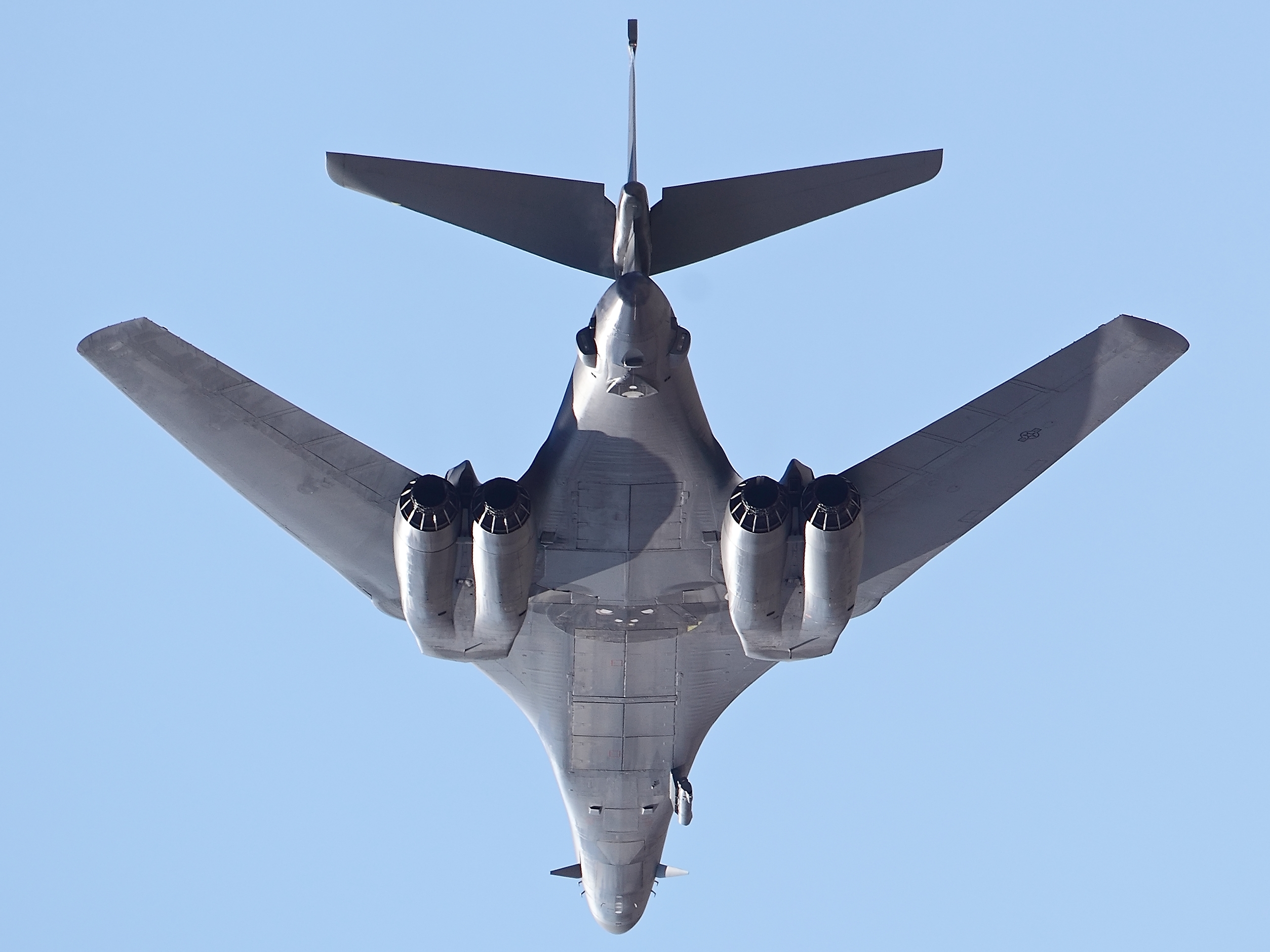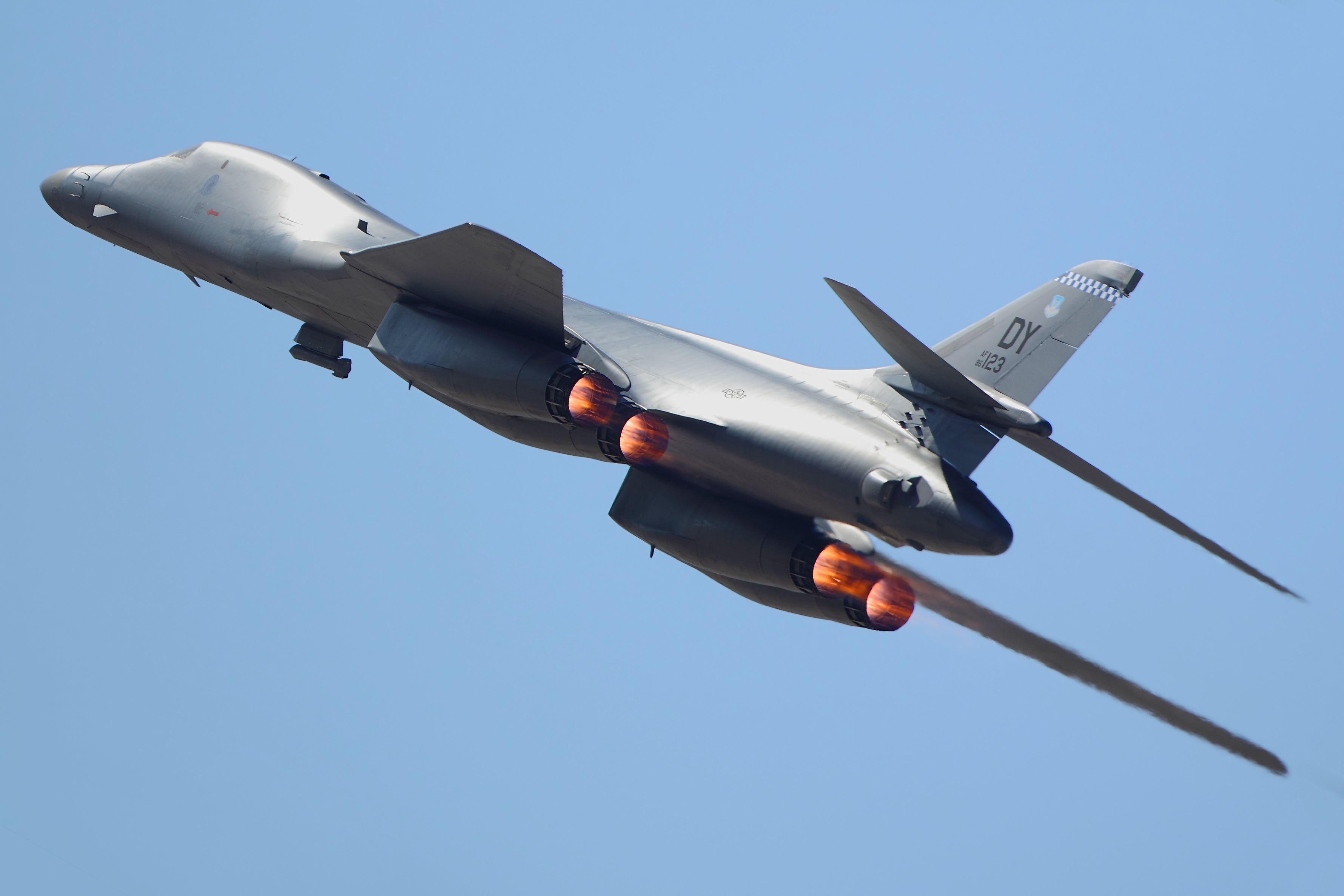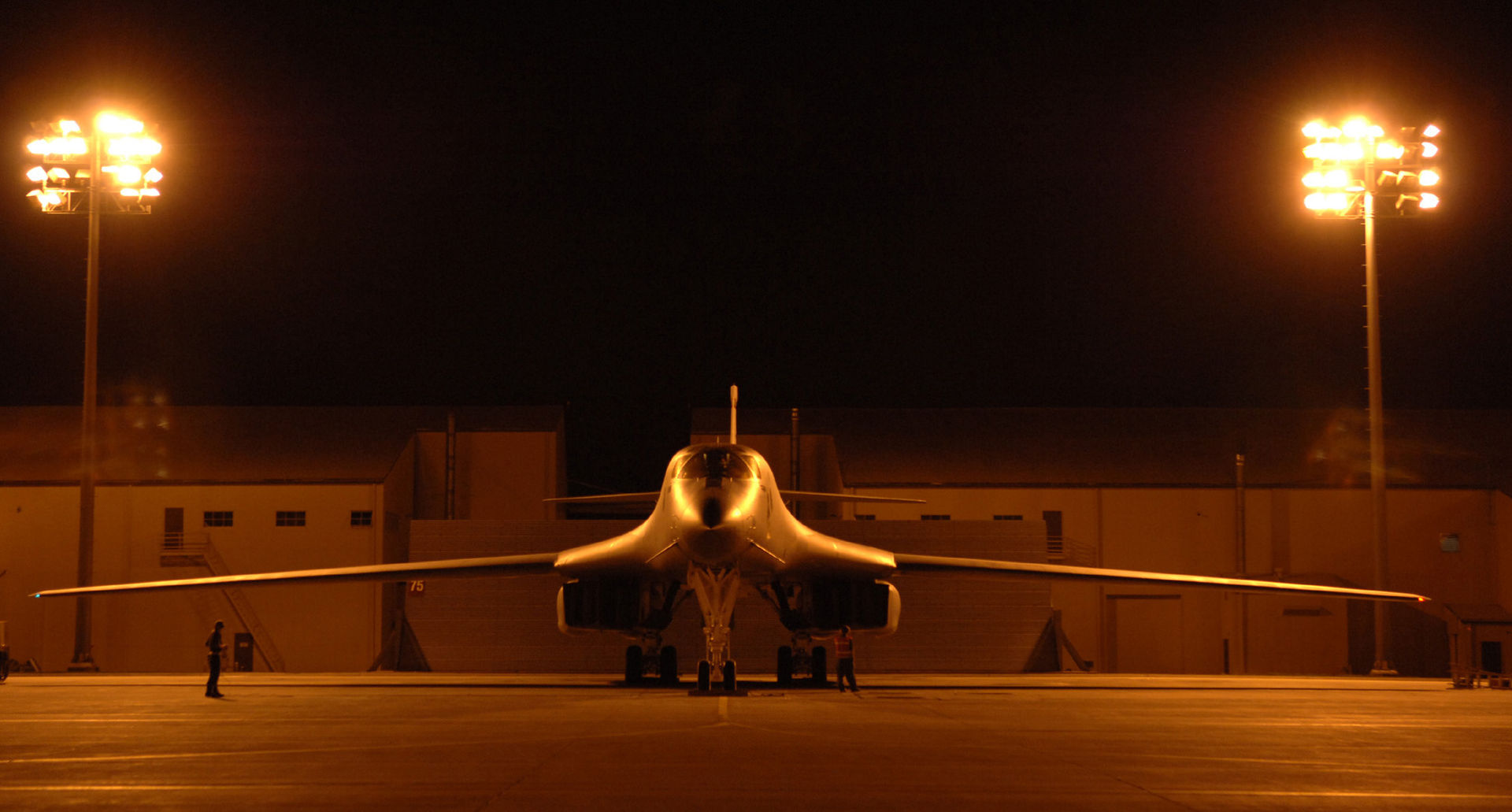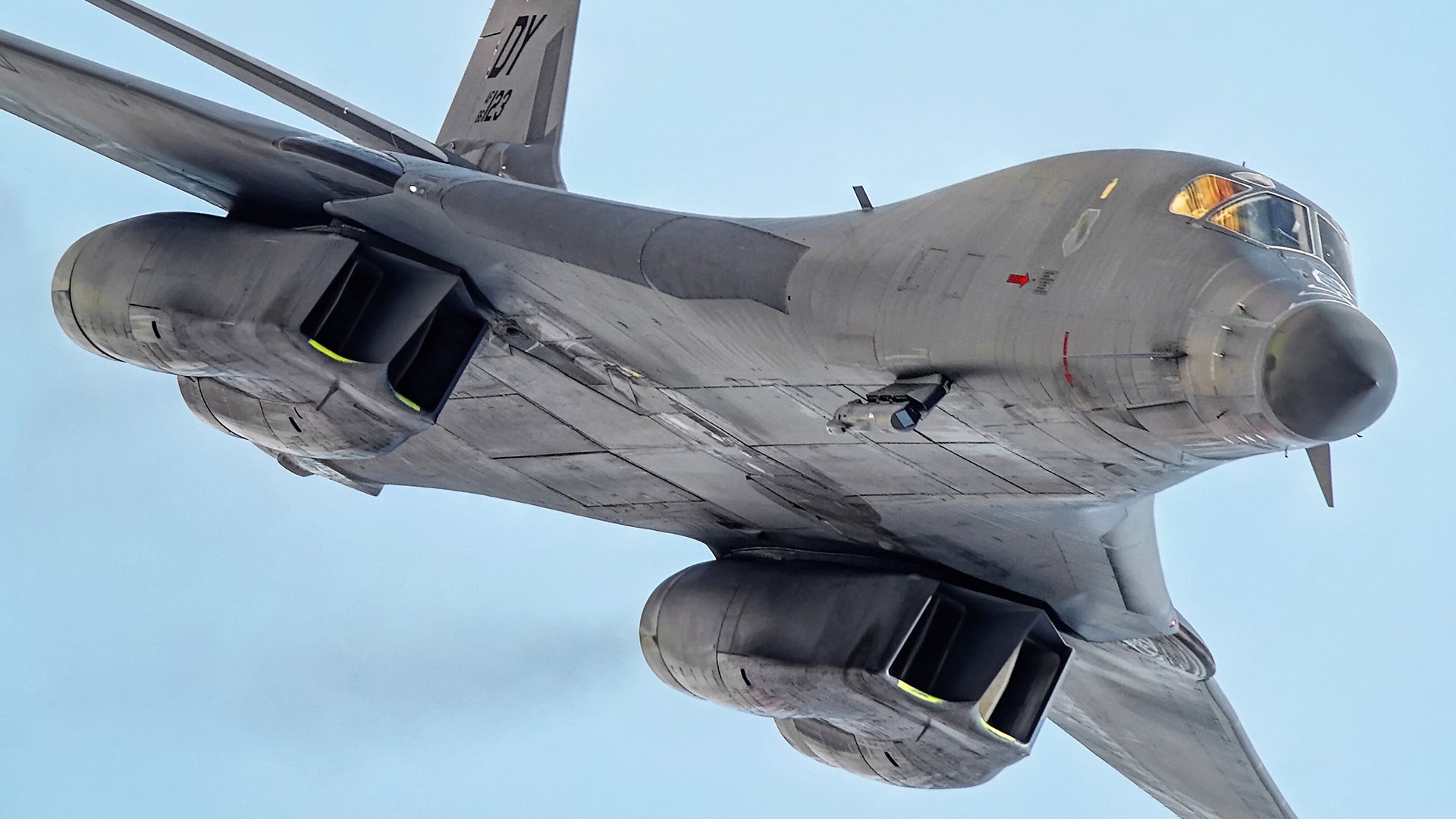Just three weeks ago, The War Zone published an expose on the current woes facing the Air Force’s tired B-1B Lancer bomber fleet. We were first to report the details of new measures aimed at prolonging the bomber’s life as much as possible. These included flight hour restrictions and an end to low-level terrain-following certification requirements, which was a staple of the training syllabus for its crews that enabled a major capability of the bomber to be used. This major change within the B-1B community definitely has its detractors, as well as its champions. Here’s where the debate currently stands, according to our sources.
There is a fair argument to be made that low-level training, which has been the source of great airframe resource depletion, has been necessary and valid. Weapons School graduates and others who develop tactics for combat aircraft think beyond weapons delivery and look at the bigger picture, including asking themselves “How can a combat aircraft be used for effect beyond dropping weapons?” There are two common ways.
Global Power As A Deterrent
The first way happens in times of peace or heightened tension, or any time the presence of bombers is needed to make a statement.
Bombers such as the B-1 have a long history of being pre-positioned overseas. The Air Force has historically referred to these bomber movements as “global power” deployments or exercises.
The presence of bombers has an effect on regional geopolitics and military decision making. Generals and politicians alike understand this and send bombers to Andersen Air Force Base on Guam, RAF Fairford in the United Kingdom, Al Udeid Air Base in Qatar, and Diego Garcia in the Indian Ocean from time to time to achieve various objectives beyond normal training and deployment requirements.
After being pulled from continuous deployments to Al Udeid in 2018, the B-1 fleet was recommitted to semi-regular global power missions.

The Show Of Force: The Main Argument For Why Low-Level Training Existed
Even in times of war, a B-1 has non-kinetic capabilities, such as being able to conduct shows of force, the reason for which B-1 aircrews and combatant commanders justify low-level training. A show of force is essentially a short, low-altitude, high-speed flyby, not unlike the ones B-1s perform at air shows. During a show of force, the aircrew maximizes the impression the B-1 leaves by making the flyby as loud and abrasive as possible, usually in full afterburner and sometimes popping MJU 23/B infrared decoy flares.
The objective is to threaten, intimidate, and ultimately force enemies who don’t want to be bombed into fleeing or at least ceasing fire. Shows are force are becoming more and more popular because they still save lives, but the justification and authorization threshold is much lower than that for dropping kinetic weapons. In 2015, the United States Air Force conducted 18,019 combat aircraft sorties in Afghanistan, but only employed weapons during 3,330 of them.
Shows of force have been used by B-1s in maritime interdiction operations, as well. The bombers conduct these missions in collaboration with the joint interagency effort to confront cartel narcotics trafficking.
Various provisions within U.S. law and the Law of Armed Conflict mean that the U.S. military can’t attack Latin American drug smugglers except in self-defense and prohibit military personnel from carrying out certain law enforcement tasks, but B-1s certainly can make their presence acutely known to traffickers. Fast-moving drug-smuggling boats from Peru, Columbia, and Bolivia have been stopped in their tracks by a B-1 show of force without a shot being fired.
If you’re a smuggler on a loud boat you may not know you’re being tailed by Customs and Border Patrol, the United States Coast Guard, or even military jets. A single show of force pass from a 146-foot-long B-1 in full afterburner low over the waves has been known to make smugglers hastily abandon ship. In that eventuality, the Coast Guard moves in and picks the smugglers up out of the water, commonly without incident.
In 2016, the Combined Air Operations Center at Al Udeid tried to limit B-1 shows of force to 2,000 feet above ground level. The deployed B-1 community there prepared an extensive and comprehensive presentation illustrating that 1,000 feet above ground level was the optimal altitude for shows of force. They narrowly won that debate.

The Argument For Real-Life Low-Level Training
B-1 operators further justify low-level training by pointing out that simulator training is insufficient. They say the simulator is ideal for crews training on complex procedures while not expending actual flight hours, but it can’t adequately prepare crews for doing a terrain-following check (preparing the AN/APQ-164 radar for terrain-following flight operations) in a combat environment, then doing a ‘letdown’ to a show of force through clouds and around terrain.
Aircrews express that the sensation of executing that letdown at night is like descending into a black hole, which requires confidence, experience, and awareness to pull off in combat.
There’s nothing like the real thing. The terrain-following check and letdown are occasional prerequisites for the show of force and if that show of force ends up causing insurgents to retreat, cease fire, or surrender, B-1 aircrews affirm the years of low-level training and expense of the airframe B-1B fleet’s collective airframe life were worth it.


The Argument Against Traditional Low-Level Training
The detractors of low-level training don’t contest how valuable shows of force are as a capability. They offer the proposition that legacy low-level training has been excessive.
Case in point: In 2018, Dyess Air Force Base proposed lengthening its frequent low-level training route, known as Instrument Route (IR) 178, to 544 nautical miles long. In 35 years and 12,000 combat sorties, no B-1 has ever flown a low-level ingress to contested or denied airspace.
In our previous article, we outlined how the B-1 Systems Program Office, along with B-1 maintainers and engineers, generally agree that low-level training has been one of the if not the biggest source of fleet wear and tear. With these factors considered, you can’t deny the detractors have a point. Especially considering that low-level show of force maneuvers are generally conducted over a single location, not along some long meandering route.
A Compromise Solution
What if B-1 crews continued to be trained and certified on low-level flight for the preservation of their show of force capability, but drastically shortened the length of their training routes? More specifically, can B-1 aircrews accomplish and satisfy show of force training with a terrain-following check and letdown as described above upon returning to base and a flyby before entering the traffic pattern?
Dyess Air Force Base already has an operating control tower and protected Class C airspace that can’t be intruded upon by aircraft that aren’t speaking with local controllers. Ellsworth Air Force Base is similar, but has Class D airspace. There are protections and increased safety offered near the B-1’s home airfields that aren’t offered on long low-level training routes.
Alternatively, this training could be executed periodically in secure airspace, such as bombing ranges and other areas away from populated areas.

The Risks Posed By Traditional Low-Level Training
There are other problems with legacy low-level training beyond airframe wear and tear. These problems are not unique to B-1s, either. Low-level training routes, such as IR 178, are depicted on civil aeronautical charts, but no airspace is reserved or set aside for them specifically. Civil and military aircraft share the airspace and they don’t have to talk to each other or controllers. In most cases, they can’t because the majority of civil aircraft don’t have UHF band radios that the military does. Previously, collisions between military aircraft conducting low-level training and civil aircraft have happened and are a risk that must be mitigated.
In addition, low-altitude high-speed flight gives aircrews fewer chances to egress a failing or crashing aircraft and increases chances of colliding with terrain or obstructions. Over the years, the statistics have caught up. Of the eight B-1 crashes, four of them, tail numbers 84-0052, 86-0106, 85-0078, and 85-0091 crashed during low-level training.
84-0052 had six crew on board and three of them died. The second two crashes were fatal for all aircrew members. The final, 85-0091 in 2013, crashed in Montana as it was exiting a low-level training route. Thankfully, all crew members survived, but it was only one of two out of the four B-1 crashes involving low-levels with no fatalities. The four other B-1 crashes resulted from various situations not related to low-level training.
Eliminating traditional low-level training in the B-1 community immediately decreases the risk of losses of life, which is paramount. A distant, but still important second consideration is the risk of losing the aircraft themselves. If we crash our nation’s military assets in training they can’t be employed in actual defense of our national interests.

It Doesn’t Have To Be All Or Nothing, Does It?
Performing short flybys for show of force training may reduce the readiness of aircrews for long-range low-level missions, and as a result, remove that capability from the bomber’s portfolio, but the concept would potentially allow aircrews to perform show of force maneuvers with confidence over the battlefield. It’s hard for anyone to justify flying a B-1 at low altitude for 544 nautical miles just to train for show of force maneuvers.
There can be no doubt this conversation has been had in formal meetings many times by those who are in charge of and develop the tactics for the B-1 program. They were brilliant enough to foster the B-1’s evolution from a nuclear deterrent into a precision strike close air support platform, and they were thoughtful enough to integrate the show of force concept soon after. Whatever transpired in those meetings, the decision was made for the entire life of the B-1 to continue training for and certifying aircrews on long-duration low-level flights, and now the bill for those decisions has come due.
Yet it seems odd that this has come down to an all or nothing proposition. Training for show of force operations can still be accomplished with far less impact on the B-1’s longevity by simply tailoring low-level training to that tactic specifically and not to low-level interdiction, which was originally meant for use during World War III.
With any luck, the Air Force will get creative about this issue and allow for the B-1 force to retain a highly useful tactic while also preserving the B-1’s airframe life for as long as possible.
Contact the editor: Tyler@thedrive.com
